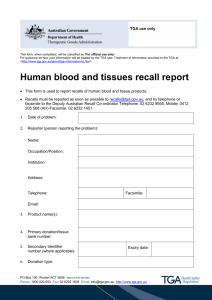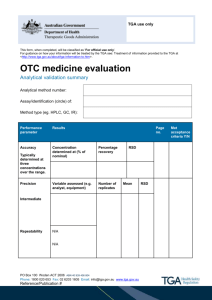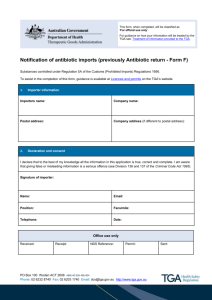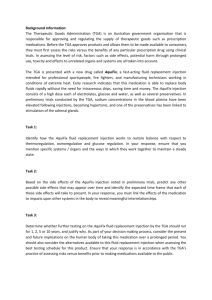Draft clinical evidence guidelines-Medical Devices
advertisement
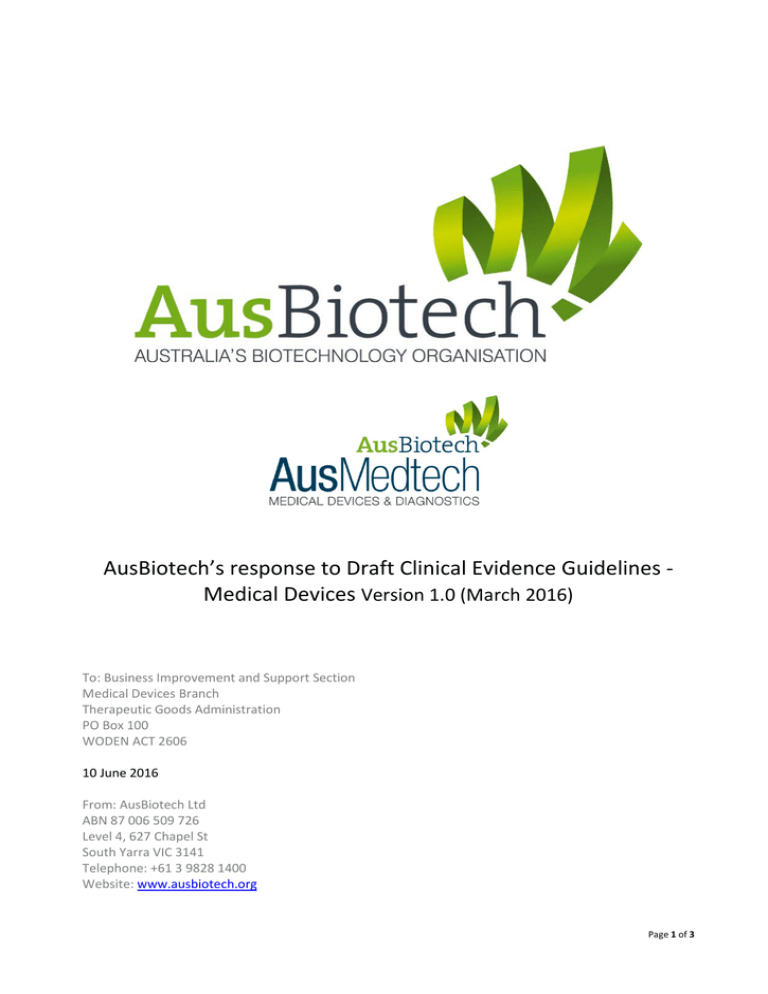
AusBiotech’s response to Draft Clinical Evidence Guidelines Medical Devices Version 1.0 (March 2016) To: Business Improvement and Support Section Medical Devices Branch Therapeutic Goods Administration PO Box 100 WODEN ACT 2606 10 June 2016 From: AusBiotech Ltd ABN 87 006 509 726 Level 4, 627 Chapel St South Yarra VIC 3141 Telephone: +61 3 9828 1400 Website: www.ausbiotech.org Page 1 of 3 AusBiotech: Draft Clinical Evidence Guidelines - Medical devices Version 1.0 (March 2016) AusBiotech is pleased to provide comments on the Draft Clinical Evidence Guidelines - Medical Devices. AusBiotech is a well-connected network of over 3,000 members in the life sciences industry, which includes bio-therapeutics, medical technology (devices and diagnostics), food technology, industrial and agricultural biotechnology sectors. The industry consists of an estimated 900 biotechnology companies (400 therapeutics and diagnostics and 400 – 900 medical technology companies) and employs in excess of 45,000 Australians. AusMedtech, an AusBiotech program, is dedicated to the development, growth and prosperity of the Australian medical technology (device and diagnostics) industry, by providing initiatives to facilitate success in product development, manufacturing and commercialisation, and encouraging links between industry, research and governments. The AusMedtech Regulatory Affairs Expert Panel is an expert group from amongst AusBiotech’s member organisations, who provide advice on matters including the regulation of medical devices. The Panel members have reviewed the consultation document and joined AusBiotech to form the basis of this submission. AusBiotech would like to commend the Therapeutic Goods Administration (TGA) on their continuing efforts to work with industry to reform and improve its service. AusBiotech is supportive of the TGA’s intended outcome to assist sponsors and manufacturers to move efficiently through the regulatory system. In particular, AusBiotech welcomes the creation of guidance documents for areas currently without adequate guidance, a comment previously articulated in our organisation’s response regarding the TGA Regulator Performance Framework, submitted 26 March 2015. The comments included in this submission recognise that the Draft does not represent an official or required position, and is provided without prejudice to generate discussion and seek constructive feedback. The submission addresses the following three areas outlined in the consultation process: 1. The utility of the Guidelines document (such as scope, structure, expression, etc.) Overall AusBiotech is satisfied with the utility of the Guidelines document with regards to its scope. To improve navigation through the document we suggest the inclusion of chapter references in the header/footer and heading and subheading numbering throughout. In addition heading and subheading numbering within chapters would assist in identifying related and non-related sections in each chapter. As practice and experience in the use of medical devices continues to evolve over time, periodic updates of the Guidelines will ensure their ongoing relevance to both the TGA and industry. AusBiotech understands that the TGA intends to implement such updates, via electronic publication, and as an organisation we support this approach. 2. The clinical and technical requirements it outlines, including any suggested improvements or corrections Definition of ‘clinical expert’ AusBiotech recommends a broadening of the definition of a ‘clinical expert’ given on page 107. We agree that a clinical expert should be “… experienced in the use of the device” and in many cases the clinical expert will be a clinician (physician) with appropriate qualifications. However, given the diversity of clinical settings in which medical devices are used, the primary user of the device may, for example, be a qualified nurse, radiographer, paramedic or audiologist. AusBiotech contends that AusBiotech: Draft Clinical Evidence Guidelines - Medical devices Version 1.0 (March 2016) because these qualified health professionals are the primary user of the device they would adequately satisfy the TGA’s criteria in terms of their level of clinical expertise. Therefore AusBiotech proposes that the definition of a clinical expert be broadened to include clinicians and qualified health professionals who are experienced in the use of the device. Clinical reports: defining the role of author AusBiotech acknowledges the TGA’s expectation that the report be prepared, or at least endorsed, by an appropriately qualified clinical expert. In practice, however, it is far more common that the report is prepared by the manufacturer, usually by in-house or external product experts, and is then reviewed and endorsed by an appropriate clinician (or clinical expert, refer to above). To ensure industry prepares clinical reports that satisfy the TGA criteria AusBiotech recommends the TGA clarify that: “Primary authorship of a clinical report may be undertaken by a clinical expert, but it is not a requirement. However it is a requirement that the clinical report be reviewed and endorsed by a clinical expert.” Definition of ‘substantial equivalence’ Chapter 5, Demonstrating Substantial Equivalence (page 34) does provide some definition around the term ‘substantial equivalence’; however, greater clarity is sought. On occasion Industry has experienced inconsistency in the way the term ‘substantial equivalence’ has been applied by TGA reviewers. Therefore defining the term more succinctly would improve consistency and understanding by industry and regulators. By way of reference, including examples similar to those found with the (Australian Regulatory Guidelines for Medical Devices (ARGMD) could assist in stakeholder understanding. 3. Suggestions for future development of further category specific sections (as covered in Chapter 6) Chapter 6: Requirements for specific high risk devices - Demonstrating the safety of Implantable Medical Devices (IMDs) in the Magnetic Resonance (MR) environment The safety of medical devices in the MR environment (page 91) is a complex area. In particular the relationship between the requirements for clinical and/or non-clinical evidence (page 92), labelling (page 103) and the patient card (page 105). It is anticipated that as part of this consultation process the TGA will take into consideration industry feedback from the ‘Requirements for MRI labelling’ review. Further, any issues and/or revisions identified are comprehensively and consistently addressed as part of both the Clinical Evidence Guidelines consultation and ‘Requirements for MRI labelling’ review process. AusBiotech encourages the TGA to consult with industry on future revisions of the Guidelines prior to publication as future categories may be identified. AusBiotech supports the development of Guidelines by the TGA. Further definition and clarification with regard to the identified areas would assist in streamlining clinical report preparation for sponsors and improve the quality of the reports submitted to the TGA for evaluation. By reducing common errors and enhancing consistency of review and regulation the TGA will address their proposed outcome of assisting sponsors and manufacturers to move more efficiently through the regulatory system.
